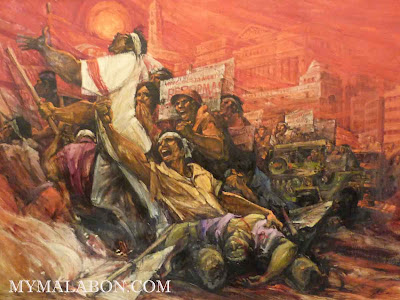 |
| The tableau is eye-catching and strange, to say the least |
Through the years, this unusual tombstone engaged my imagination and obviously that of many others, because it has been featured on television and in some newspaper and magazine articles.
To this day, the tableau never fails to draw attention, especially on All Saints' Day when the living troop to the cemeteries to remember their dead loved ones.
WHO HAD THAT STATUE MADE AND WHY?
Don Simeon Bernardo of Barangay Concepcion had it made. In a GMA News feature in 2007, the grandson who was interviewed by Kara David said that it was his grandfather's express wish to have the statues placed on his tomb. He also said that contrary to what some people think, Don Simeon was not a satanist; that he was in fact, a very prayerful person.
As to why he had it made, the stone inscription at the left side of the statue, I believe, holds the answer. When I went to take pictures last Wednesday, the lettering was barely readable. A video grab of the GMA News feature three years ago shows that the inscription was readable then.
 |
| Video grab from GMA News feature in 2007 |
LUCIFER: Bakit ka nakikialam sa kaharian ko dito sa lupa ay hindi na kayo kundi ako ang hari, ako ang nagturo kay Eva at Adan kaya nagkaroon ng sangkatauhan.
SAN MIGUEL: Ang lupa at langit ay gawa ng aking panginoon, kaya hanggang dito ang aming kapangyarihan.
LUCIFER: Bulaan hambog, kung ano ang ibig ko siya ritong masusunod at hindi ang ibig mo - digmaan, arihan, dayaan, sugal, lahat ng layaw ng katawan naibibigay ko sa tao, pati mga alagad ng mga panginoon mo, napapasunod ko, ano pa ang ginagawa mo rito?
SAN MIGUEL (SA SARILI): Panginoon kong nasa langit nasaan ang kapangyarihan mo?
SAN MIGUEL: Tao, tulungan ninyo ako na labanan ang kasamaan, pairalin ang katarungan at pagibig sa kapwa, iwasan ang kasakiman sa salapi at kapangyarihan na pinagmumulan ng ligalig.
I thought that Don Simeon composed the dialogue himself. But according to Mr. Florentino Bernardo, another grandson of Don Simeon, it is believed that the above passage was taken by Don Simeon from the Bible. He noted that during the Spanish times when his grandfather lived, ordinary citizens were prohibited from reading the Bible by the friars. However, I notice that there is no attribution to a Bible verse on the stone inscription.
In response to my query on whether Don Simeon left any autobiography or memoirs to explain his motivation, Mr. Bernardo said that his grandfather did not. It seems the latter simply had the statues and inscription made while he was still alive and left instructions that these were to be placed on his grave. But he believes their Lolo Simeon had that unusual tombstone made as a reminder to everyone about what was happening in the world.
Apparently echoing Mang Floren's belief, a great grandson, Mr. Lubis Bernardo, said that the late Atty. Sumilang Bernardo, daughter of Don Simeon, once told them that the reason why her father had the statues made was that he believed evil was prevailing over good in the world.
In the late 70s, according to Lubis, Atty. Sumilang asked him to replace the statues because they had been destroyed by addicts. It so happened that the replacement statues were bigger than the original (by approximately five inches), and it seems there was even talk by some people who didn't know about the replacement, that the devil was getting bigger!
Both Lubis and his Uncle Floren mentioned that a relative of theirs once said they could remove the statues if people changed for the better and good really prevailed in the world.
If indeed Don Simeon Bernardo's intention was to remind us, I'd say he has pretty much succeeded.
And for this he will be remembered... long after he has passed on from this world that he believed needed reminding.
 |
| The anguished look on St. Michael's face says it all. Seeing this I think I pretty much understand what might have been Don Simeon's concern, which motivated him to have this unusual scene sculpted in stone. |
 |
| The remains of Don Simeon Bernardo have since been transferred to a memorial park and other relatives are interred here. The stone inscription to the left was all white and barely readable when I dropped by. |
.




































